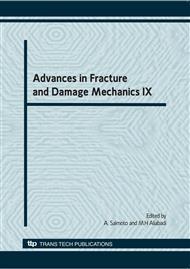p.361
p.365
p.369
p.373
p.377
p.381
p.385
p.389
p.393
Damage Evolution of Composite Laminates with Digital Image Correlation
Abstract:
DIC (Digital Image Correlation) based methodology gives full field measure of the displacement using a well defined algorithm for matching the images of loaded and load free component, so that displacement in a plane can be evaluated for a certain number of grid reference points on the analysed surface. In this work, the authors present an application of DIC technique to analyse fatigue damage phenomena in two notched GFRC laminates under tensile load. Damage analysis based on optical DIC technique has been performed to detect the damaged areas on the specimen surface. The damage evolution and failure mechanism has been followed monitoring two parameters: the local hysteresis area of stress-strain cycles, the local stiffness variation.
Info:
Periodical:
Pages:
377-380
Citation:
Online since:
November 2010
Keywords:
Price:
Сopyright:
© 2011 Trans Tech Publications Ltd. All Rights Reserved
Share:
Citation:


